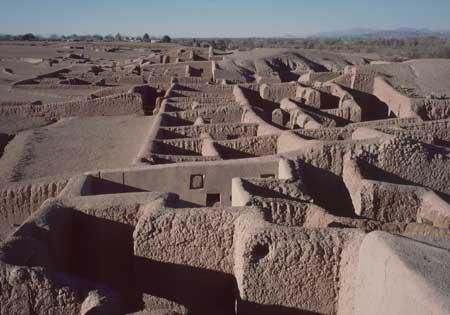March 10, 2016
First Proof of Corn Beer Use in the Southwest Found at Paquime
Researchers are studying the fossilized teeth of ancient inhabitants of Casas Grandes (Paquime), in Chihuahua. The first conclusive evidence of the use of corn beer in the ancient Southwest has been found in the teeth of the inhabitants. Paquime housed 3000 people at its height in the 14th century. It was a major trading post between Mesoamerican and the Southwest. The tartar on the teeth of the dead traps elements that have been ingested and mineralize over time. 110 individuals remains were tested, buried between 700-1450 CE. 63 had mineralized remains. 10% of the samples yielded corn smut (huitlacoche), an edible fungus that is still a delicacy today. Three samples showed fermentation that would have been used to make chicha, a corn beer that was in use for 5000 years in Mesoamerica and South America. The fermented granules dated to 1200-1450 CE.
Western Digs has the report here;
http://bit.ly/1QKvN3j
Mike Ruggeri’s Aztlan World
http://mikeruggerisaztlanworld.tumblr.com
Mike Ruggeri's Casas Grandes World Magazine
http://bit.ly/1ztd8vF

ON SOWÍ OR LOCAL CHIHUAHUA CORN BEER
RE: CORN BEER IN PAQUIME AND 2 CORN REVOLUTIONS
Tuesday, 15, March, 2016
Two very important informations in just 2 Aztlan Bulletin notes, that lead us to change completly our understanding of ancient peoples:
If there was 2 main kinds of corn, it means there was 2 big revolutions:
First, people could have a very important source for food and other uses (at Paquime they used corn as fuel for ceramics, getting temperatures as high as to produce glass on the walls of the ovens, a mexican archeologist working there told me some 5 years ago). But after, with this other corn that can produce starch and be fermented, a huge change in culture also happened. Fermented corn sprouts to produce Sowí or Sowiki, or Batari -in Raramuri language, Sugí in West Ralámuli--, is very important and central to Raramuri people all over Chihuahua, living around the extended Paquime area and the Sierra Tarahumara; as it is also for the Odami -”tepehuan”- in the South, into Durango, but also among Yoreme or Yaki and Mayo peoples in the West, in Sonora and Sinaloa, and Wizrárika in the Nayar to the West -Durango-Nayarit-San Luis Potosí.
The word Tesgüino now very common, seems to have come with the Spaniards from the Jalisco area, and also some anglo-americans report the use of the word Tiswin among athabascan groups in the SouthWest -“apaches”- in the 19th Century.
The importance of sowiki in Raramuri ceremonies along the whole year, is related to a complex cultural system of symbolic references: Is the main mean to share all the produce with all beings, mostly those up there, on the “heavens”: After openning a sowiki pot to start drinking, the man in charge of the ceremony throws a little bit of the liquid first in direction to the heavens and after to the underground, and later to the 4 directions, so they share it in drinking along, and saying thanks to all the beings related, basic for the cultivation and harvest of corn: from the ones that send the rain on time, birds, etc. After, the drink is offered first to the social leader of the community, and then in descending order in the jerarchy of the whole community, which shows the social-political organization clearly. Everybody knows how to make Sowí, and is made in every house-family, as much as possible. In good years, people who has more corn can produce more Batari and so do more ceremonies, inviting all.
The use is so important that in 79 I proposed that it was present in the ceremony performed at Teotihuacan for the Creation of the Fifth Sun, in the person of Nanahuatzin, the “poor” humble man that first threw himself into the fire to generate the sun. In some places, people still do that, throw some Sowí to the fire, in sharing with the OldLord of Fire.
Now, we have to re think all about in time, as this precisions give a new very clear panorama. In Chihuahua there are some 8 to 10 varieties of corn known among the Raramuri, with different carachteristics, for different uses and also adapted to certain climatic-geographical areas. Some are “hard”, some are “sweet”. All mentioned in the Don Burgess book -2010- with what Ralamuli of the Western Chihuahua Sierra told him, and an article by Robert Bye -who did his Harvard PhD on the area on ethnobotany in the 60s-, and Edelmira Linares, both at the National University Botanical Garden in Mexico City. The book is in Ralamuli and Spanish: With Corn is possible to do many things.
This needs a long consideration, and it means also to extend a lot, which I’ll have to do in a much longer text.
Thanks anyway to all involved in this.
Luis Urias